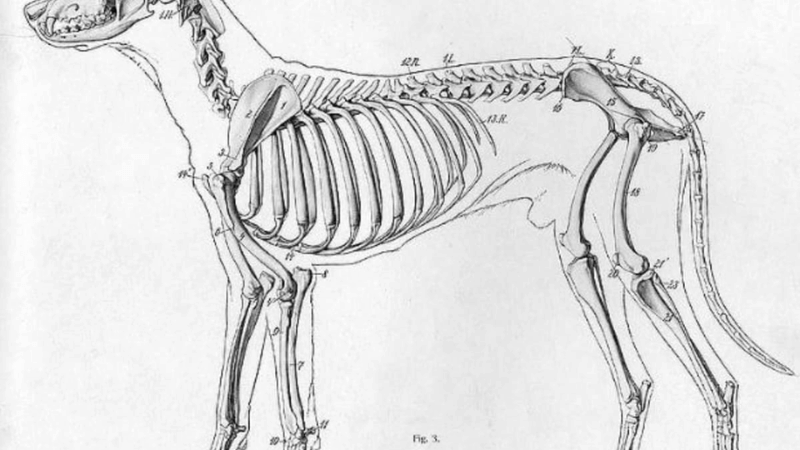Introduction
The canine skeletal system is a fascinating topic for dog lovers and those interested in understanding how dogs move and function. One question that frequently arises is whether dogs have collar bones, also known as clavicles, like humans. In this article, we will explore canine anatomy, the role of collar bones in humans, and whether dogs have collar bones. Additionally, we'll discuss unique features of the canine skeletal structure and how evolutionary adaptations have influenced the dog's body.
Understanding Canine Anatomy
Canine Skeletal System
A dog's body comprises approximately 319 bones (depending on the breed and individual variations), which provide support, and protection for internal organs, and facilitate movement. The canine skeletal system can be divided into two main categories: the axial skeleton (including the skull, spine, ribs, and sternum) and the appendicular skeleton (consisting of the limbs and pelvic girdle).
Comparing Canine and Human Skeletal Structures
Although there are some similarities between dog and human skeletons, such as the presence of a spine, ribs, and limbs, there are also significant differences. These differences result from the unique evolutionary adaptations in dogs, which have shaped their skeletal structure to suit their needs and lifestyle.
The Clavicle: Collar Bones in Humans
The function of the Clavicle in Humans
In humans, the clavicle, or collar bone, plays a crucial role in supporting the shoulder joint and serves as a connection between the axial and appendicular skeleton. The collarbones help stabilize the shoulder girdle and allow humans to perform various upper-body movements and maintain an upright posture.
Common Collar Bone Injuries in Humans
Collar bone injuries are relatively common in humans, typically resulting from falls, sports accidents, or car collisions. Symptoms of a broken collarbone may include pain, swelling, and difficulty moving the affected arm. Treatment usually involves immobilization using a sling, pain management, and physical therapy, with surgical intervention reserved for severe cases.
Do Dogs Have Collar Bones?
Presence of Clavicle in Dogs
Dogs do have a vestigial clavicle, but it is not a functional collar bone like in humans. The vestigial clavicle in dogs is a small, rudimentary bone that doesn't connect to other bones and is embedded within a ligament. This tiny bone has little to no impact on the dog's overall skeletal structure or function.
How Dogs Compensate for the Lack of Functional Collar Bones
In dogs, the scapula (shoulder blade) and surrounding muscles play a significant role in supporting and stabilizing the shoulder joint. The absence of a functional collar bone allows for greater flexibility and range of motion in the shoulder, contributing to a dog's agility and mobility.

Unique Features of Canine Skeletal Structure
Notable Differences Between Canine and Human Skeletons
There are several differences between canine and human skeletons. For example, dogs have a dewclaw, an extra "toe" located higher up on the leg that doesn't touch the ground. Additionally, the structure of the canine spine differs from that of humans, with dogs having more vertebrae and a more elongated shape.
Evolutionary Adaptations in Dogs
The absence of a functional clavicle in dogs is an evolutionary adaptation that benefits their mobility and agility. This adaptation allows dogs to move more efficiently while running, jumping, and maneuvering, making them well-suited for their roles as hunters, herders, and companions.
Frequently Asked Questions About Dog Collar Bones
Why don't dogs have collar bones like humans?
Dogs don't have functional collar bones like humans because their evolutionary adaptations have favored a more flexible and mobile shoulder joint. The absence of a functional clavicle allows dogs to have a greater range of motion in their front limbs, which is beneficial for running, jumping, and other activities.
How does a dog's shoulder joint work without a collarbone?
A dog's shoulder joint relies on the scapula (shoulder blade) and the surrounding muscles to provide support and stability. The muscles around the shoulder joint play a crucial role in maintaining stability while allowing for a wide range of motion. This structure enables dogs to move efficiently and effectively in various activities.
Are there any disadvantages for dogs not having a functional collarbone?
There are no significant disadvantages for dogs not having a functional collarbone. The absence of a functional clavicle is an evolutionary adaptation that has provided dogs with increased mobility and agility. In fact, the lack of a functional collar bone is advantageous for dogs, as it allows them to perform a wide range of activities with ease.
Related Article : How to Measure Dog Collar
Conclusion
While dogs do have a vestigial clavicle, they do not possess a functional collarbone like humans. This absence of a functional collar bone is an evolutionary adaptation that has allowed dogs to develop increased mobility and agility in their front limbs. The canine skeletal system has many unique features that have evolved to meet the specific needs of dogs in their various roles as hunters, herders, and companions.
Understanding the intricacies of canine anatomies, such as the presence or absence of collar bones, can provide valuable insights into your dog's health, movement, and behavior. Always consult with a veterinarian or a canine health professional if you have concerns about your dog's skeletal structure or overall well-being.

